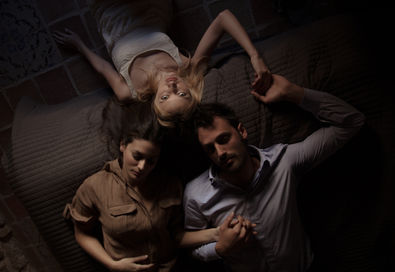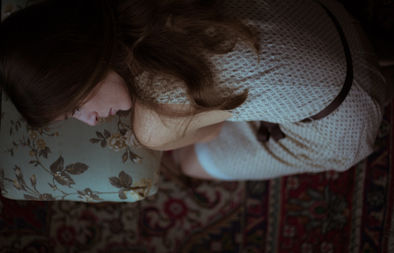FOTOTECA SIRACUSANA
PHOTOGALLERY - FOTOGRAFIA VINTAGE - BIBLIOTECA TEMATICA - CAMERA OSCURA B&W - DIDATTICA
SCRIPTPHOTOGRAPHY
Paola SCHILLACI (IT)

PAOLA SCHILLACI
La paura corre più in fretta di ogni certezza. In “Il re della pioggia” lo scrittore americano Saul Bellow scrive: “La paura governa il genere umano. Il suo è il più vasto dei domini. Ti fa sbiancare come una candela. Non c’è nulla nel creato più abbondante della paura. Come forza modellatrice è seconda solo alla natura stessa”. Tutti noi conosciamo l’addiaccio della paura, la sua fredda morsa stringersi intorno mentre ci ordina di vivere una vita a metà. La paura cambia, si corregge, si trasforma, si adatta ai mutamenti socio-economici e culturali della società fino a modificare la qualità del vivere. Ed è in questo cono d’ombra della nostra esistenza che la paura fonda il suo regno. La fotografa Paola Schillaci in “Ne timete” (dal Latino, in Italiano “Non abbiate timore”) esplora le diramazioni della paura nell’ambito di un preciso campione generazionale: i soggetti ritratti hanno tutti intorno ai trent’anni, un periodo nel quale la paura mostra per intero ogni sua sfaccettatura. Le paure dei bambini non sono le stesse degli adulti: noi temiamo le cose che desideriamo di più, ma la corsa ad ottenerle spesso è sbarrata da convenzioni esterne che hanno il potere di radicarsi in noi fino a generarne di nuove, lasciandoci nel tormento dell’inadeguatezza. Paure personali, paure collettive. “Ne timete” esplora quasi chirurgicamente le perfide sottigliezze che arrembano la vita quotidiana di persone troppo vecchie per essere giovani e troppo giovani per essere degli adulti ma tutte accomunate da una sensazione di disagio che, riflettendosi in ogni ambito della vita, apprendiamo che non è solo generazionale. Paure antiche, paure nuove. Paola Schillaci ordisce delle metafore affrontando con la necessaria delicatezza, ma con l’onestà che merita trattare il disagio, entrando in profondità nella relazione con l’osservatore il quale, osservando le sue fotografie, riconoscerà l’umana avventura di chi “di paura ha il cor compunto” (Dante Alighieri) rispecchiandosi nel riflesso d’ognuno dei timori. “Ne timete”, come si è detto, si addentra nelle declinazioni della paura. Disagio, incertezza, dubbio, esitazione. Sensazioni che congelano l’anima per reclutarci alla schiavitù dell’immobilità. Ed è proprio questo che cogliamo osservando le fotografie, una glaciale immobilità che attanaglia i soggetti per collocarli nella dimensione nebulosa del dubbio, avvolti da un’atmosfera che a tratti sconfina nella disistima e nell’inadeguatezza ad affrontare qualsiasi scelta. La paura corrode lo spirito, lo gela, lo cattura e ne fa frantumi. Ecco dunque che scegliere sembra la più ardua e complicata delle operazioni – mentre sboccia il fiore velenoso dell’immobilità. Ma la paura, sembra dirci Paola Schillaci nel suo bel progetto, è un coro le cui voci non si sommano: ognuno ha la propria con cui patteggiare: la paura d’essere abbandonati, lo sgomento di sentire intorno indifferenza e freddezza, la solitudine, il timore del giudizio altrui, scoprirsi fragile e attaccabile – e non soltanto nel versante morale – la precarietà lavorativa cui ci costringe una società malata e infine, la più grande di tutte, la più escatologica delle paure: ammalarsi e morire. Mentre osserviamo “Ne timete” apprendiamo come il “catalogo delle paure” si arricchisca con il mutare dei tempi, aggiungendo a quelle insite nell’animo umano le paure generate dalla contemporaneità. Tutto è fluido, incerto, aggredibile e il fotografo che ne osserva i cambiamenti ha il dovere documentale di registrarne l’evoluzione. Paola Schillaci osserva. Osserva e traduce con garbo e delicatezza, prerogative che naturalmente confluiscono nelle fotografie del progetto. La sensibilità con cui ha organizzato la composizione trasuda insieme pathos ed empatia, così come i dettagli – ben scelti – cui affidare il ruolo di narrare un sentimento più complesso e la cui efficacia raggiunge l’obiettivo. Ma sono molti gli elementi che convincono. La luce nella quale sono immersi i soggetti, ora oscura quasi a compenetrarli ora accesa e “piatta”, ma il cui stridore con il tema sottolinea ancor più il disagio, è una luce che assume un ruolo fondamentale, che esalta e stordisce. In ogni luogo. Che sia un interno – si noti la composizione pop di un nucleo familiare alle prese con la fine di un dialogo relazionale o la giovane con i capelli bluastri alle prese col tormento d’essere giudicata – o un esterno, come ad esempio la giovane donna immersa nella glacialità di un sottopassaggio o, ancora, trovarsi letteralmente “in mezzo a una strada” in seguito alla perdita del lavoro, il quadro complessivo è funzionale e teso al completamento di un assunto che inderogabilmente obbedisce alla logica di una buona rappresentazione che convinca anche sotto il profilo estetico. Con “Ne timete” Paola Schillaci però ci invita a uno scatto, a una elaborazione del malessere e alla sua risoluzione. E l’invito è già nel titolo in Italiano, nella sua traduzione dal Latino: “Non abbiate timore”, a mostrarvi fragili, incompleti: dopo ogni pioggia arriva il sole ad asciugarla.
Giuseppe Cicozzetti
da “Ne timete”
foto Paola Schillaci
Fear runs faster than any certainty. In "Henderson The Rain King" the American writer Saul Bellow writes: "Fear rules mankind. His is the largest of the domains. It makes you whiten like a candle. There is nothing in creation more abundant than fear. As a modeling force it is second only to nature itself ".
We all know the coldness of fear, its cold vise clinging around while ordering us to live a life in half. Fear changes, corrects itself, transforms itself, adapts itself to the socio-economic and cultural changes of society until it changes the quality of life. And it is in this shadow of our existence that fear bases its reign.
The photographer Paola Schillaci in "Ne timete" (from Latin, in Italian "Don’t be afraid") explores the branches of fear within a specific generational sample: the subjects portrayed are all around the age of thirty, a period in which the fear shows its every facet in its entirety.
Children's fears are not the same as adults: we fear the things we desire the most, but the race to get them is often barred by external conventions that have the power to take root in us until we generate new ones, leaving us in the torment of inadequacy. Personal fears, collective fears.
"Timete" almost surgically explores the treacherous subtleties that raise the daily life of people too old to be young and too young to be adults but all share a feeling of unease that, reflecting in every area of life, we learn that it is not only generational. Ancient fears, new fears. Paola Schillaci weaves metaphors facing with the necessary delicacy, but with the honesty that deserves to deal with the discomfort, entering deep into the relationship with the observer who, observing his photographs, will recognize the human adventure of those "of fear has a filled heart "(Dante Alighieri) mirrored in the reflection of each of the fears.
"Ne timete", as we said, goes into the declensions of fear. Uneasiness, uncertainty, doubt, hesitation. Feelings that freeze the soul to recruit us to the slavery of immobility. And it is precisely this that we catch watching the photographs, an icy immobility that grips the subjects to place them in the nebulous dimension of the doubt, enveloped in an atmosphere that at times overflows in the disesteem and inadequacy to face any choice.
Fear corrodes the spirit, freezes it, captures it and shatters it. Here, then, that to choose seems the most difficult and complicated of operations - while the poisonous flower of immobility blossoms. But fear, Paola Schillaci seems to tell us in her beautiful project, is a chorus whose voices do not add up: everyone has their own to cope with: the fear of being abandoned, the dismay of feeling around indifference and coldness, loneliness, the fear of the judgment of others, discovering fragile and attackable - and not only in the moral side - the job precariousness that forces us to a sick society and finally, the greatest of all, the most eschatological of fears: to get sick and die.
As we observe "Ne timete" we learn how the "catalog of fears" is enriched with the changing of the times, adding to those inherent in the human soul the fears generated by the contemporaneity. Everything is fluid, uncertain, aggressive and the photographer who observes the changes has a documentary duty to record its evolution. Paola Schillaci observes. She observes and translates with grace and delicacy, prerogatives that naturally flow into the photographs of her project.
The sensitivity with which she organized the composition exudes pathos and empathy together, as well as the details - well chosen - to entrust the role of narrating a more complex feeling and whose effectiveness reaches the goal. But there are many elements that convince. The light in which the subjects are immersed, now obscure almost to interpenetrate them, now lit and "flat", but whose screeching with the theme emphasizes even more the discomfort, is a light that assumes a fundamental role, which exalts and stuns. Everywhere.
Be it an interior - note the pop composition of a family struggling with the end of a relationship dialogue or the young woman with blue hair grappling with the torment of being judged - or an outside, such as the young woman immersed in the glaciality of an underpass or, again, to be literally "in the middle of a road" following the loss of work, the overall picture is functional and aimed at completing an assumption that inevitably obeys the logic of a good representation that also convinces the aesthetic profile.
With "Ne timete" Paola Schillaci, however, invites us to take a snap, to elaborate the malaise and its resolution. And the invitation is already in the title in Italian, in its Latin translation: "Don’t be afraid", to show you fragile, incomplete: after every rain the sun comes to dry it.
Giuseppe Cicozzetti
from “Ne timete”
ph. Paola Schillaci










